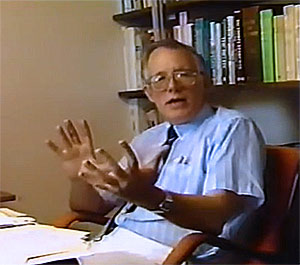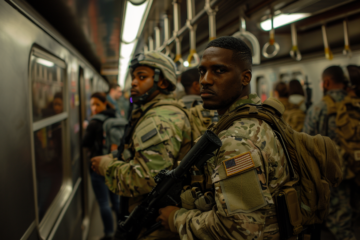Structural Guidelines
 by Dr. William L. Pierce (pictured)
by Dr. William L. Pierce (pictured)
ONE OF THE greatest difficulties some Alliance members have is reconciling present Alliance activities with long-term Alliance goals. They expect the Alliance to be doing the sorts of things right-wing organizations traditionally do, such as carrying protests signs in the streets, issuing ultimatums to the government, putting up candidates for public office, and so on. Because the Alliance is expending only a minimal amount of energy on such activities at this time, there is a tendency to dismiss the Alliance as “just a publishing organization.”
Another difficulty is understanding why the Alliance addresses itself to a rather more perceptive and intelligent audience than right-wing groups generally do, instead of addressing itself to “the masses.”
These difficulties are caused by a failure to appreciate the nature of the task the Alliance faces and an ignorance of the Alliance’s strategy for accomplishing that task.
The long-range goal of the Alliance is bringing about a fundamental transformation of human life on this planet. A showdown with the System will not be the culmination of our struggle, but only an acute phase. And the purely political aspect of our struggle is only a temporary aspect, and far from the most significant in the long run.
The aims of the Alliance, as indicated in the preceding paragraph, go so far beyond those of traditionalists, conservative, right-wing, or other racially oriented organizations that thinking of the Alliance in familiar right-wing terms can only lead to confusion and misunderstanding. The first step, then, in understanding the synopsis which follows is clearing one’s mind of all right-wing notions and remembering that the Alliance is unique.
The strategy of the Alliance consists of three elements. The first element is to build a functioning structure of cadres: men and women of exceptional character and intelligence who share the Alliance’s world view, are unconditionally committed to the Alliance’s goals, and form integral, fully participating units in the Alliance structure. The second element is to use the Alliance structure to exert an educational influence on the general populace (“the masses”). The third element is to use the Alliance structure in a radical manner at such time as its capabilities and the situation of the system combine to give the Alliance sufficient historical leverage to effect a radical and permanent change leading to the Alliance’s superseding the System.
The tendency of right-wing organizations is to omit the first element (and sometimes the second also) and to attempt a short cut which will either yield political power to the organization or compel the System to reform itself — immediately. Examples are the Wallace movement of the late 1960s and early 1970s and the conglomeration of tax-revolt groups springing up today.
In the first example the theory was that a righteously outraged citizenry would sweep a crusading hero (George Wallace) into the White House, and the hero would then throw out the bums currently entrenched in the Federal bureaucracy, persuade the Congress and the courts to go along with a general rollback of the liberal-leftist legislation enacted since the advent of Franklin Roosevelt, and restore America to strength, honor, and White precedence.
In the second example the theory is that if a sufficiently large number of people refuse to pay income taxes — and if property taxes are rolled back by referendum — the System’s water can be cut off and the government brought to its knees. Then the government will be obligated to reform itself, cutting out such programs as school busing, handouts to minorities, etc.
The errors inherent in these and other right-wing schemes will be analyzed in detail elsewhere. Here it must suffice to say that the proponents of both the schemes mentioned above tend to vastly oversimplify the cause of the problems their schemes are intended to remedy, and they also tend to misunderstand the political mechanisms by which their schemes are supposed to work.
They tend to blame America’s ills almost exclusively on a small group of conspirators — Federal bureaucrats, Jewish media masters, international bankers, “trilateralists,” or what have you — who are thwarting the essentially healthy wishes of the majority of the electorate and subverting a society with essentially sound institutions. They fail to recognize the moral sickness that permeates our society and affects nearly all its members.
They tend to think in terms of “quick fixes,” superficial changes such as a Constitutional amendment or a purge of conspirators, which leave the social structure of the country and the values on which it is based unchanged. They do not understand — as in the case of the tax rebels — that, even if their efforts bring about a major restructuring of the tax laws (even an elimination of all income taxes), the System will simply change its modus operandi and continue on its racially destructive path.
Finally, they do not realize that, because no mere handful of revolutionary leaders can control or change the course of anything so massive and complex as American society, no one-man revolution, or a coup d’etat by a small group of right wingers, can possibly succeed.
But the Alliance does not make these errors. It aims, in the first place, at total revolution, not at reform. It understands that an effective revolution must gain total control of every social estate and institution — not just eliminate a few men in Washington and New York — and that, therefore, a disciplined army of men and women capable of replacing the entire social superstructure of the nation must be built.
The first two elements of the Alliance’s strategy, to be sure, are not independent. While we build our organizational structure, we carry on a propaganda directed at a larger segment of society than the elite from which we draw cadres, because the material and moral support for our cadres must come from a sufficiently broad base to allow continued growth. We must understand, however, the nature of the structure we need to build, if we are to apportion emphasis correctly between these elements.
Propaganda directed exclusively or even primarily at “the masses” — agitational, issue-oriented, non-ideological propaganda — serves relatively little purpose at this time, for two reasons. The first reason is that the Alliance cannot compete effectively with the mass media, the schools, the churches, and the government in forming public opinion or arousing public feeling. Only when the Alliance has become much larger and is able to generate a much greater volume of propaganda can it have a significant public effect. Therefore, the primary (but not necessarily exclusive) aim of its propaganda at this time must be recruitment and building support. This reason is easy to understand and finds little disagreement.
The second reason arises form the type of recruit the Alliance seeks, and in this matter there tends to be some misunderstanding. There is a widespread assumption, even among people who should know better, that the richest recruiting ground for the Alliance is those sectors of the White population most in distress as result of the racial, social, and economic policies of the System — persons threatened by Black invasions of their neighborhoods or by Black hiring quotas, for example.
Experience proves this not to be so. Not one of the persons who has yet come forward to become an Alliance cadre has come as a result of an acutely distressing situation. Each has come for one and the same reason: because we tell the truth, and he has recognized that truth in what we say.
The acutely distressed person wants help, and he wants it now. We cannot give it to him. He may support — for a while — the organization which promises help, but he will not give up his dream of what he thinks of as a normal life for a life of revolutionary hardship, for years and decades of struggle nourished only by a dream of a distant ideal. Only the ideologue will do that, and it is, therefore, the ideologue to whom we must primarily appeal at this time.
We look forward, of course, to the time when the Alliance is not only much larger but also much closer to a culmination of its struggle against the System. Then those who are acutely distressed can honestly and credibly be given promises of help, and the Alliance may in turn expect — even demand — some form of limited participation by them in its struggle. Until that time, however, it is a foolish diversion of Alliance resources and an inexcusable waste of time — not to mention credibility — to attempt to fire up such people with revolutionary enthusiasm. For now they will remain only in supporting roles, at most, and those who design our propaganda must take this fact into account.
We seek even now whatever support the conservatives, the acutely distressed, and other non-revolutionaries are capable of giving us. A portion of our propaganda is directed toward them. But we do not deceive ourselves as to what to expect from them. We know, in fact, that the great majority of White Americans will never be ideologues but will always be more concerned with bread-and butter issues than with fundamental principles. And this will also be true of the majority of our subscribers, our supporters, and even our members. Our propaganda cannot ignore such people and their interests.
But the foundation and framework of our structure must be built before the siding and the shingles go on. Before we can utilize masses of people who neither completely understand what we are trying to achieve nor are wholly committed to us, we must be absolutely certain that every department of the Alliance, at every level down to the neighborhood or factory cell, is under the firm control of cadres who do understand what it’s all about and are totally and unconditionally committed to us.
When the time comes that we are able to set up front groups, those groups may do or say whatever is best suited to their immediate purposes. But the Alliance itself will never cater to right-wing prejudices, exploit populist fads, or hop on conservative bandwagons. Nor will we shift the emphasis of our message so that it is directed primarily to “the masses” instead of to an elite minority, regardless of what other groups are doing. The Alliance will always be the one organization which sticks to the straight and narrow path and tells the truth, the whole truth, and nothing but the truth.
This strategy will mean a smaller membership for the Alliance for some time to come, but a much higher quality membership. In the long run it will give the Alliance an essential advantage over everyone else.
For, even though we cannot ourselves make a revolution but must depend upon the forces of history to do that for us, we must be prepared to win a revolution at the opportune moment. And we can only win though organization. Not by waving our arms and shouting revolutionary slogans to “the masses.”
We are building our organization step by step, carefully and soundly. We are building it in a functional manner, developing its necessary capabilities one by one. We have already built the capability for publishing a better revolutionary newspaper than that of any other organization. We have the very best writers and editors.
Now, even as our newspaper continues to develop and grow, we must add new functions, new capabilities, to our organization. Closely associated with, and overlapping to a certain extent, our journalistic function is a newly developing capability for producing other types of printed propaganda: novels (The Turner Diaries), comic books, pamphlets (Bolshevism from Moses to Lenin), etc. As this capability continues to develop, we will be able to fully utilize the talents and energies of more and more different types of writers, artists, and researchers. Eventually the printed-propaganda arm of the Alliance must be continuously generating a veritable flood of new material, ranging from serious newspapers to ideologically oriented romances and agitational pamphlets.
But even as this arm continues to grow, we need other capabilities. We need, for example, a fund-raising capability: a branch of the Alliance consisting of people with an expertise in obtaining the money we must have, whether from mass mailings, personal solicitations, or other means. We have no such cadres on our staff now.
We need a legal capability, not only for defending ourselves in the courts when necessary, but also for using the courts in an aggressive manner, for going on the offensive legally when the opportunity arises. At the present we have not even one legal cadre in the Washington area.
We need a business capability, a sales capability, for building the circulation of our newspaper and our other publications. This capability will require cadres who concern themselves with placing our publications in independent bookstores and newsstands, with advertising in other publications (including the mass media), with establishing and maintaining far larger numbers of news racks for NV sales than we have now. This is an extremely important capability, and it is one which is almost nonexistent now. It cannot wait much longer.
We will need a public-speaking capability, a branch of the Alliance concerned with carrying our message orally to groups of people everywhere, whether to a meeting of patriotic organizations or to bystanders at a public protest demonstration. Occasionally one or another cadre now on the National Office staff does this, but we need cadres who specialize in it, who learn how to find and exploit every opportunity for doing it, who learn how to make their own opportunities.
And we will need, one day, a branch of the Alliance which has the capability for dealing successfully in an extra-legal way with extra-legal attacks against us. That is, we must eventually develop a military capability.
* * *
Source: National Alliance BULLETIN, August-September 1978





